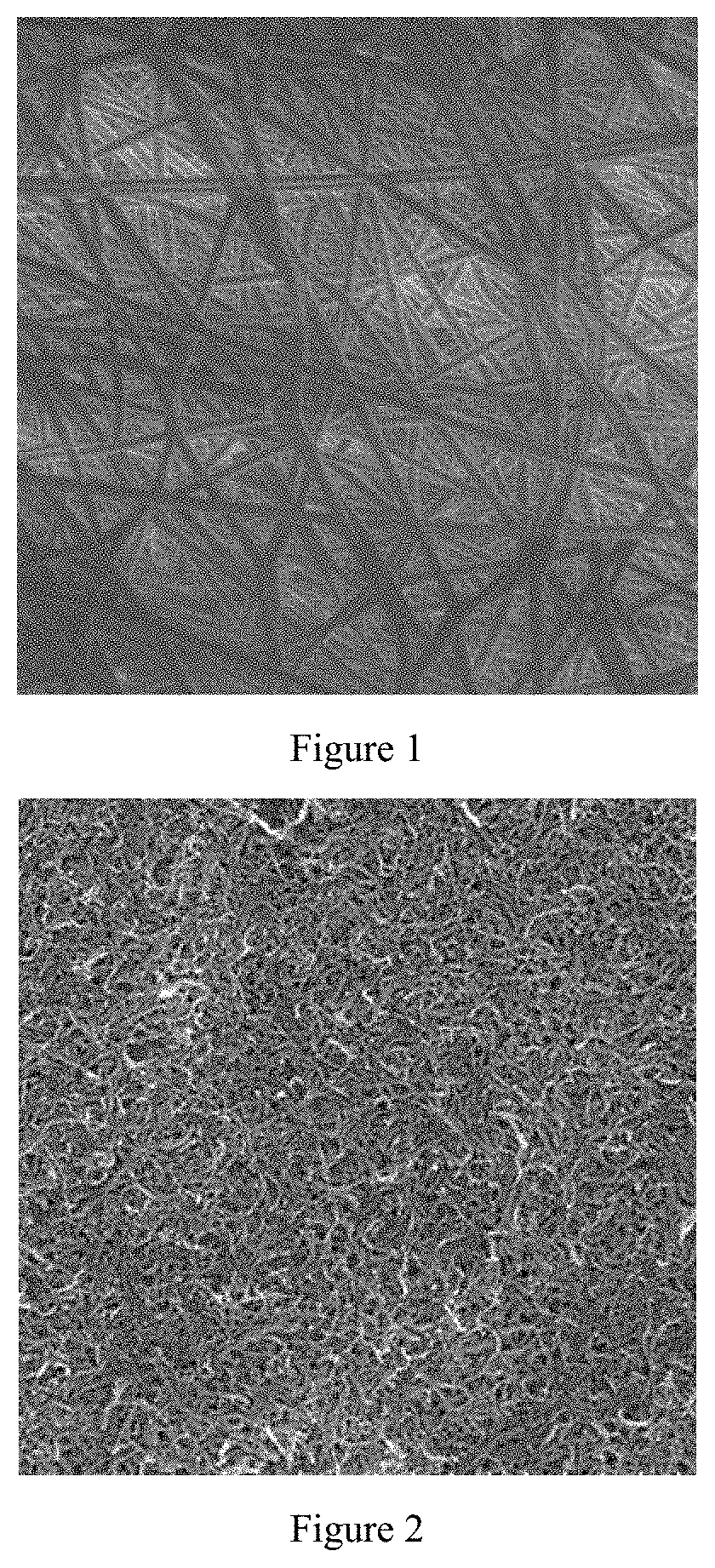Carbon nanotube/nanofiber conductive composite membrane and preparation method thereof
a carbon nanotube and composite membrane technology, applied in the field of membranes, can solve the problems of restricting the further development and application of membrane separation technology, cnt separation membrane, affecting the performance and application of the above cnt separation membranes,
- Summary
- Abstract
- Description
- Claims
- Application Information
AI Technical Summary
Benefits of technology
Problems solved by technology
Method used
Image
Examples
embodiment 1
of CNTs / Polyacrylonitrile (PAN) Nanofiber Composite Flat Membranes
[0039]The First Step: Preparation of Nanofiber Matrix by Electrospinning
[0040]The polymer PAN used as a support layer is dissolved in N, N-dimethylformamide(DMF) to form a spinning solution with a mass fraction of 15%. The electrospinning voltage density is fit to around 1 kV / cm and the spinning distance is in the range of 10-20 cm. The spinning time is controlled at 10 h according to the concentration. The corresponding nanofiber matrix is obtained from the collector and set to hot-press at 150° C. to obtain a flat nanofiber support layer.
[0041]The Second Step: Preparation of CNTs Functional Layer by Electrostatic Spraying
[0042]The CNTs with diameter of 60-100 nm acidified by mixed acids are dispersed in water to prepare a 5 mg / mL dispersion. Then, then nanofiber matrix is electrostatically sprayed for 6 h at the controlled voltage density of around 1 kV / cm and the spinning distance in the range of 10-20 cm.
[0043]The...
embodiment 2
of CNTs / PAN Nanofiber Composite Hollow Fiber Membranes
[0046]The First Step: Preparation of Nanofiber Matrix by Electrospinning
[0047]The polymer PAN used as the matrix is dissolved in DMF to forma spinning solution with a mass fraction of 15%. The electrospinning voltage density is controlled to around 1 kV / cm and the spinning distance is in the range of 10 cm. A stainless steel wire collector is used as a receiving apparatus. The spinning time is controlled at 6 h according to the concentration. Then, the corresponding nanofiber hollow fiber support layer is obtained from the receiving apparatus.
[0048]The Second Step: Preparation of CNTs Functional Layer by Electrostatic Spraying
[0049]The 60-100 nm CNTs acidified by mixed acids are dispersed in water to prepare a 5-10 mg / mL dispersion. Then, then a no fiber matrix is electrostatically sprayed for 6 h at the controlled voltage density of around 1 kV / cm and the spinning distance in the range of 10-20 cm.
[0050]The Third Step: Crosslink...
embodiment 3
of CNTs / Polyvinylidene Fluoride(PVDF) Nanofiber Composite Flat Membranes
[0053]The First Step: Preparation of Nanofiber Support Layer by Electrospinning
[0054]The polymer PVDF used as the matrix is dissolved in the mixture of DMF and acetone (volume ratio 9:1) to form a spinning solution with a mass fraction of 18%. The electrospinning voltage density is fit to around 1 kV / cm and the spinning distance is in the range of 10 cm. The spinning time is controlled at 10 h according to the concentration. Then, the nanofibers are directly removed from the collector and set to hot-press at 80° C. to form a flat nanofiber matrix.
[0055]The Second Step: Preparation of CNTs Functional Layer by Electrostatic Spraying
[0056]The 10-20 nm CNTs acidified by mixed acids are dispersed in water to prepare a 5-10 mg / mL dispersion. Then, then nanofiber matrix is electrostatically sprayed for 6 h at the controlled voltage density of around 1 kV / cm and the spinning distance in the range of 10-20 cm.
[0057]The T...
PUM
| Property | Measurement | Unit |
|---|---|---|
| Temperature | aaaaa | aaaaa |
| Length | aaaaa | aaaaa |
| Molar density | aaaaa | aaaaa |
Abstract
Description
Claims
Application Information
 Login to View More
Login to View More - R&D
- Intellectual Property
- Life Sciences
- Materials
- Tech Scout
- Unparalleled Data Quality
- Higher Quality Content
- 60% Fewer Hallucinations
Browse by: Latest US Patents, China's latest patents, Technical Efficacy Thesaurus, Application Domain, Technology Topic, Popular Technical Reports.
© 2025 PatSnap. All rights reserved.Legal|Privacy policy|Modern Slavery Act Transparency Statement|Sitemap|About US| Contact US: help@patsnap.com

